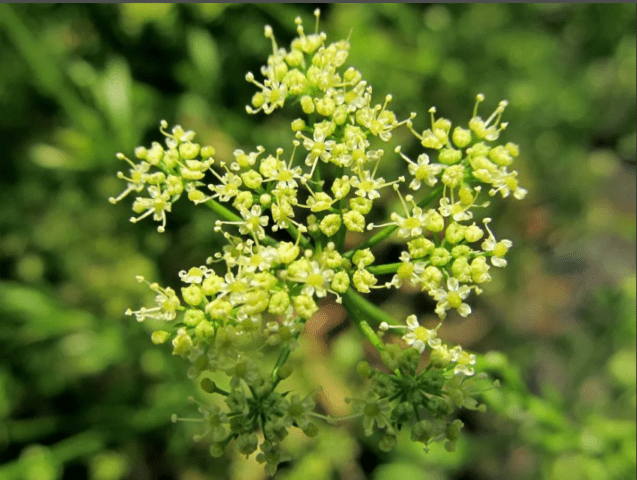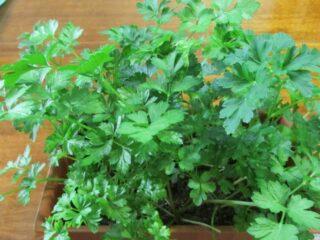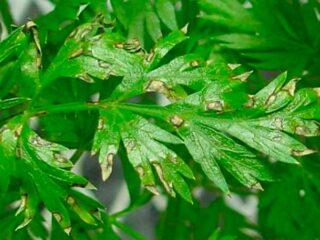Content
- 1 History of appearance
- 2 Description of curly parsley with photo
- 3 The best varieties of curly parsley
- 4 The health benefits and harms of curly parsley
- 5 Methods of application
- 6 Advantages and disadvantages of curly parsley
- 7 Why curly parsley is banned in Russia
- 8 Landing Features
- 9 Caring for curly parsley
- 10 Diseases and pests of curly parsley
- 11 Conclusion
Curly parsley is a spicy aromatic plant that immediately attracts attention with its decorative effect. She is unpretentious in care, in addition to this, she has other advantages; she is not without culture and disadvantages.
History of appearance
Curly parsley is a “spontaneous” mutation of ordinary leaf parsley. Its homeland is the Mediterranean, where culture dates back to about the 6th century BC. e. The ancient Egyptians and Greeks were the first to meet. However, they began to grow it en masse only in the 9th-10th centuries, when the plant “reached” continental Europe.
There, curly parsley was first considered an ornamental crop, planted in flower beds and parks. But soon it became serious “competition” to its “classical” variety. The prevalence was facilitated by the pronounced dissimilarity with the so-called “dog parsley”.
Description of curly parsley with photo
Curly parsley (Petroselinum Crispum) is a herbaceous plant from the family (Umbelliferae). In principle, it is biennial, but gardeners in most cases cultivate it as an annual.
The plant has a fleshy, well-developed spindle-shaped tap root. It is a rosette of leaves 30-80 cm high on long petioles.

The leaf rosettes are quite dense and do not “fall apart”
The intensively branching stem and “umbrella” inflorescences appear on it only in the second season. After flowering, the fruits ripen.

Most gardeners do not wait for curly parsley to bloom.
The shape of the pinnately dissected leaf, depending on the variety, varies from triangular to heart-shaped. The edges are strongly corrugated and wavy, which is why they appear “openwork”.

The leaves of curly parsley are thin, very graceful
The best varieties of curly parsley
There are quite a lot of varieties bred by Russian and foreign breeders. However, in the opinion of a non-specialist, the differences in appearance and taste between them are insignificant.
Mooskrause-2
Early maturing curly parsley from Germany. Greens can be cut 55-70 days after mass germination. The sockets are powerful and spreading.

The Mooskrause-2 variety quickly recovers after cutting and produces 2-3 “harvests” per season
Aster
Ultra early (55-60 days) variety. The rosette is slightly “raised”, quite dense, of medium height. The leaves are large, strongly corrugated.

The approximate yield of the Astra variety is 4-5 kg/m² per season
Bravo
Early (60-65) days old domestic variety. The rosettes are almost vertical, the leaves have long petioles.It is recommended to cut the leaf blades to the growth point - this way the bush recovers faster.

The Bravo variety, even compared to other varieties, stands out for its endurance and undemanding care
Royal velvet
Late (120-130 days) variety. Rosette of medium height, densely leafy. The leaf blades are small, highly corrugated.

The Royal Velvet variety is characterized by a high concentration of mineral salts in the roots and greens
The health benefits and harms of curly parsley
Curly parsley is extremely beneficial for health. This is due to the richness of the chemical composition. Greens and roots contain:
- macro- and microelements (sodium, potassium, phosphorus, calcium, magnesium, zinc, iron, sulfur);
- vitamins (A, C, group B, PP);
- pectin;
- flavonoids;
- phytoncides;
- essential oils;
- fatty acid;
- mineral salts.

In terms of vitamin C content, curly parsley is ahead of citrus fruits
When regularly included in the diet, the “multifaceted” beneficial effects of greens on the body are noted:
- increasing immunity;
- restoration of vision;
- comprehensive improvement of oral health (strengthening teeth, whitening enamel, neutralizing unpleasant odor);
- protection against free radicals that provoke premature aging of the body;
- “support” of the cardiovascular system;
- normalization of metabolism and water-salt balance;
- improvement of blood composition;
- prevention and “relief” of inflammatory processes in the joints and spine;
- participation in the removal of waste and toxins from the body;
- restoration of appetite.

The healing properties of the herb are also recognized by official medicine.
However, there are also contraindications for the use of curly parsley, in the presence of which it becomes hazardous to health:
- individual intolerance;
- chronic diseases of the genitourinary system and kidneys – cystitis, nephritis, urolithiasis;
- the period of gestation and natural feeding of the child.
Methods of application
Curly parsley is most often used in cooking. This is an almost universal seasoning. It is added to soups, meat, poultry, fish, game, and salads. It is also widely used in home canning of vegetables.

In summer, curly parsley can be added to any “seasonal” fresh vegetable salad.
In home cosmetology, the plant’s ability to lighten the skin and smooth out fine wrinkles is in demand. The greens and pulp of the roots are used as an ingredient in masks designed to combat hyperpigmentation, dark circles under the eyes and the first signs of aging.

Parsley mask is an effective “express remedy” for combating unhealthy complexion and restoring skin tone
In folk medicine, the anti-inflammatory, bactericidal, urinary, bile- and diaphoretic, antispasmodic, anesthetic, and wound-healing properties of the plant are in demand. The drugs are “prescribed” for problems with the cardiovascular, bronchopulmonary, endocrine, and digestive systems.
Advantages and disadvantages of curly parsley
Among the undoubted advantages of this variety are:
- originality and decorative appearance;
- compactness of the plant, combined with good “yield”;
- low maintenance requirements;
- suitability for cultivation in open ground, greenhouses, and at home.
However, according to some criteria, curly parsley loses to “classic” parsley:
- less pronounced aroma;
- the odor almost completely disappears after heat treatment and drying;
- harsh fresh greens.

When dried, curly parsley has almost no smell
Why curly parsley is banned in Russia
Since 2011, curly parsley has been included in the “List of Plants Containing Potent, Narcotic or Toxic Substances,” which is part of SanPiN. The reason for its inclusion in the list was the substances contained in the essential oil obtained from the seeds:
- apiol and apiolic acid;
- myristicin;
- alyltetramethoxybenzene;
- alpha-pinene;
- ketone.
Theoretically, the body can react to the use of essential oil with attacks of unmotivated aggression, euphoria, panic and fear, and uncontrollable laughter. Hashish and hemp provide approximately the same effect.
However, the inclusion of curly parsley in this list does not mean a ban on its cultivation, sale of herbs and its consumption. Criminal liability can only be faced by those who cultivate it on an industrial scale. And only if representatives of law enforcement agencies prove that the purpose of cultivation was precisely to obtain essential oil from seeds and its further sale as a narcotic substance.

There is no need for urgent destruction of curly parsley plantings
Landing Features
The place for any greenery in the garden is often chosen “on the residual principle”.But a good harvest can be harvested only if it is provided with long daylight hours and sufficiently fertile soil that combines nutritional value and looseness. A “heavy” substrate in which moisture stagnates, or even “openwork” partial shade, is absolutely not suitable.
Soil preparation
The bed for growing greens is prepared around mid-autumn. The selected area is cleared of stones, plant and other debris, and dug to a depth of approximately one spade bayonet. In spring, the soil is deeply loosened and leveled.

During the digging process, the soil is “enriched” with humus (3-5 l/m²) and complex fertilizer (10-15 g/m²) is applied.
The planting site is chosen taking into account the rules of crop rotation. Areas after other Umbrella plants (dill, celery) are not suitable for it. Desirable predecessors are any types of cabbage, onions, garlic, Solanaceae, Pumpkin or Legumes.
Sowing seeds
Due to the high concentration of essential oils, the seeds do not have good germination. To increase it, they are soaked in warm water or a biostimulant solution for 18-24 hours.
The seeds are quite large, they can be placed one at a time in grooves 1-1.5 cm deep with an interval of 8-15 cm. The approximate row spacing is 15-25 cm (depending on the variety).
First, the grooves are well shed with water and allowed to be absorbed. After sowing the seeds, they are covered with humus or fertile soil and moistened again.

Before the appearance of “friendly” shoots, the bed with curly parsley is covered with plastic film or black covering material
Caring for curly parsley
Even novice gardeners can grow curly parsley. Her care includes:
- Watering. Curly parsley tolerates short-term drought better than waterlogged soil. If there is no frequent and heavy rain, the beds are watered approximately once a week, spending 4-5 l/m². In hot weather, the intervals are reduced to 3-4 days.
- Weeding and loosening. These measures become unnecessary if you mulch the bed immediately after sowing the seeds. Otherwise, it will have to be loosened 3-4 times per season and weeded as needed.
- Thinning. It is carried out in the phase of the second true leaf, if the seeds are planted “in a heap”, 2-3 pieces each. The most powerful and developed sprout is left in the garden bed; the others are cut off at the root with scissors.
- Feeding. Whether curly parsley needs them depends on whether it is grown as an annual or perennial crop. In the first case, you can do without fertilizers if the bed has been prepared according to all recommendations. Otherwise, curly parsley is fed twice a season - with nitrogen (in the 3-4 leaf phase) and with a complex preparation.

Weeds for curly parsley are serious “competitors” in the fight for water and nutrients
Diseases and pests of curly parsley
The culture's disease resistance is quite good. But in the absence of even minimal care and planting in the wrong place, it can become infected with fungi:
- Powdery mildew. A grayish-white coating, similar to powder, gradually darkens to a lilac-gray color, covering the leaves in a continuous layer.
Tissues affected by powdery mildew die, dry out or rot
- Cercospora blight. Greenish-yellow spots appear on the leaves. Gradually, the fabrics lighten almost to transparency, and a darker “edge” appears around.
The risk of developing cercospora blight increases markedly with “crowding” in the bed with curly parsley and regular waterlogging of the soil
- Rust. The leaves (mostly from the inside) are covered with spots of a “fluffy” orange-yellow coating. Quite quickly it tightens the leaf plate completely, “compacting” and changing color to rusty brick.
Curly parsley affected by rust, if nothing is done, dries out in 3-4 weeks
- Stolbur. The leaves turn red, the plants quickly dry out and die.
Curly parsley seeds from specimens affected by stolbur are unsuitable for sowing - they are already infected with the virus
With the exception of stolbur, for which there are no means to combat it yet, other diseases typical of curly parsley are fungal. If they are noticed at an early stage, it is enough to treat the bed and the plants themselves with fungicides 2-3 times.
For many insects, the aroma of curly parsley is unpleasant, and the greens are inedible due to the high concentration of essential oils. But there are exceptions:
- Melon aphid. Small greenish-yellow or black-brown insects that settle on curly parsley bushes in whole colonies. They feed on its juice, preferring to suck it from the most tender young leaves.
Young leaves of curly parsley are formed from the center of the rosette, so aphids settle there first
- Carrot fly. Adults lay eggs on rosettes of curly parsley.The emerging larvae feed on leaves.
Despite the name, the carrot fly attacks not only carrots, but also any other Umbrella
- Stem nematode. Thin worms live in the soil and penetrate into the plant through microdamage to the roots. They gradually move up the petioles of curly parsley leaves, eating away the tissue from the inside and contaminating them with waste products.
Curly parsley affected by stem nematode seems to wither for no apparent reason.
Almost any broad-spectrum insecticide will be effective against aphids and carrot flies. It is better to prevent nematode attacks in advance by adding granules of specialized long-acting preparations to the soil in the spring (before planting curly parsley).
Conclusion
Curly parsley is a plant that is actively used not only in cooking, but also in folk medicine and home cosmetology. The greenery has a rich chemical composition; original “carved” leaves decorate the beds. Even novice gardeners can grow curly parsley; planting it is not prohibited.















